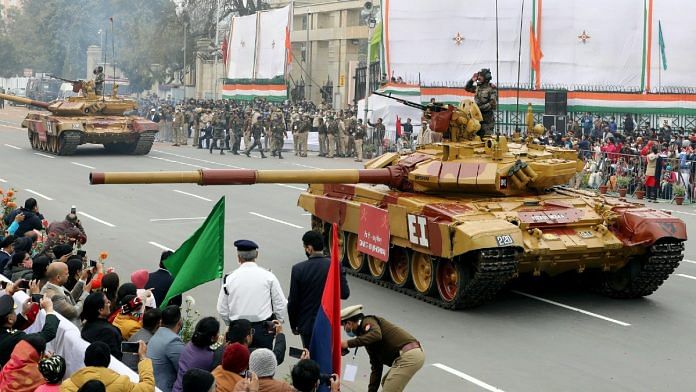New Delhi: The Defence Acquisition Council (DAC) in a 30 November meeting accorded an Acceptance of Necessity (AoN) for the procurement and integration of two types of technology — the Automatic Target Tracker (ATT) and Digital Ballistic Computer (DBC), both part of the fire control system — for T-90 tanks.
An AoN is basically an approval granted by the defence ministry at the start of the procurement process. The Russian-made T-90 and T-72 tanks form the backbone of the Indian Army’s armoured capabilities.
The Army as of today operates up to 1,200 T-90 tanks, while around 475 more are in the making, a highly-placed source in the defence establishment told ThePrint. While the 1,200 existing tanks will be upgraded, the ones in the making will come with a built-in ATT, the source added.
On how this tech is expected to help the Army, the source said: “They will help the T-90s get better sight to spot the enemy [tank] easily.”
ATT technology helps in precise engagement with moving targets. As of now, to hit a target accurately, the T-90 tanks are positioned manually.
“In case of moving targets, the tank operator tracks the target by mentally estimating the time and speed the target will require to get to a certain point and then fire the round,” the source explained, adding that this increases the risk of missing the target.
The DBC, which is used for the fire guidance system, calculates the trajectory of the round based on the atmospheric conditions. A round of ammunition generally gets affected by the atmospheric temperature conditions, temperature inside the tank, and wind conditions such as the speed and direction. The DBC makes calculations based on all these factors in order to hit a target accurately.
The computer currently installed in the tanks is analogue in nature and systems are being digitised to remove the scope for human error and bias, according to sources.
Apart from the T-90s, the Army operates nearly 2,400 T-72 tanks which too do not have the ATT and DBC.
The Army is also in the process of acquiring 1,700 Future Ready Combat Vehicles (FRCV), which will gradually replace the T-72 tanks. The FRCVs will be equipped with Battlefield Management System (BMS), a source in the Army told ThePrint.
Explaining how this will help during conflicts, the source said: “It will provide better situational awareness for the tank commander by marking the position of the enemy tanks along with other details, such as their status of ammunition, which will help in better planning.”
Also Read: Replacing ageing Cheetah/Chetak choppers to take at least 10 yrs, hopes pinned on LUH & leasing
Tanks under debate
India is investing heavily in the development, acquisition and restoration of tanks at a time when the role of tanks in battlefields is being debated, especially in the wake of the Russia-Ukraine war.
The Army has reportedly issued a tender to support its programme for the restoration and life extension of in-service T-72 tanks. Moreover, the Ministry of Defence in 2021 placed an order with Heavy Vehicles Factory in Chennai for supply of 118 Main Battle Tanks (MBTs) Arjun Mk-1A. The prototype of the indigenous Zorawar Light Tank is also expected to roll out by the end of December.
Many global strategic experts believe that tanks are here to stay and that the contest between tanks and anti-tank systems has been constant, while several others argue that tanks are being pushed into obsolescence.
Indian experts, however, believe that tanks are here to stay for at least a little longer.
Speaking to ThePrint, Maj Gen B.S. Dhanoa (retd) said the principal role of the tank has remained unchanged since World War II.
“What has emerged clearly is the threat posed to the behemoths of land power by new technologies, which include a newer generation of anti-tank guided missiles, as well as unmanned aerial systems carrying a plethora of detection and kinetic anti-tank munitions and electronic warfare suites that render a tank’s own electronic systems susceptible to attacks,” he asserted.
He added that the tank still remained a symbol of national will and deterrence, and that its role in combined arms’ warfare due to the key tenets of mobility, firepower and protection, remained undiminished.
On the offence, a tank provides mobile and protected lethality on the battlefield to enable ground-force manoeuvres. On the defence, a tank is used against another tank at a range of one to two kilometres. Tanks remain a key ground component of combined-arms warfare, without which other arms are more vulnerable, according to the retired officer.
“Infantry are vulnerable when attempting to seize defensive positions, thus tanks still play a critical role during offensive operations. Anti-tank guided missiles certainly cannot replace the tank’s role in supporting manoeuvres,” Maj Gen Dhanoa said.
(Edited by Nida Fatima Siddiqui)
Also Read: India-made loitering munitions to swarm drones, Army showcases new hi-tech offensive capability






